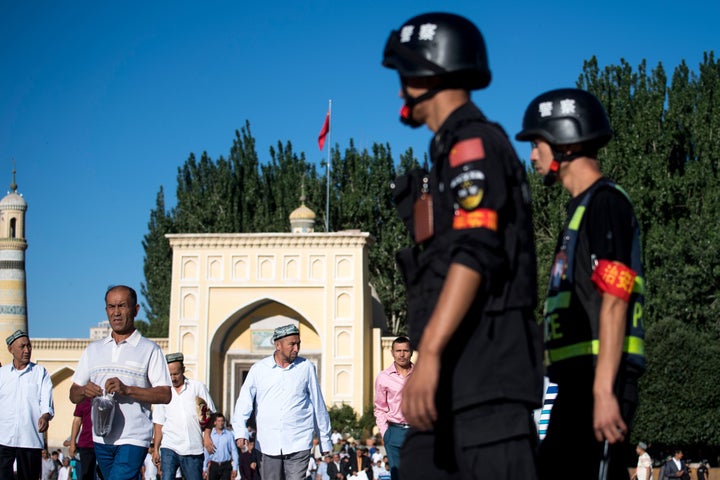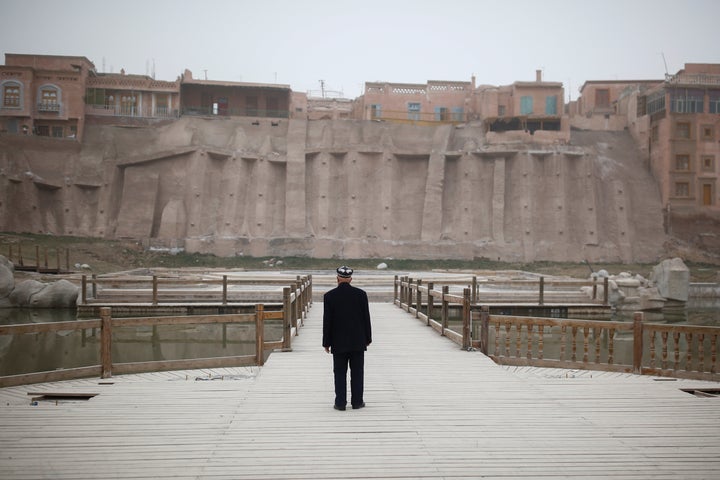In China’s northwestern Xinjiang region, an area with long-simmering unrest between the ethnic Uighur (pronounced “we-gur”) minority and the Han Chinese majority, the government has detained more than a million members of this and other Muslim groups in what’s been described as a “massive internment camp that is shrouded in secrecy.”
That was the finding of a United Nations panel earlier this month, which cited “credible reports” from the region. Chinese U.N. delegate Hu Lianhe dismissed the reports as “completely untrue,” but he did acknowledge that some Uighurs the government determines to be “deceived by religious extremism” have been “assisted through resettlement and education.”
In other words: They’re being detained and indoctrinated. The only real matter of dispute is just how many of Xinjiang’s roughly 10 million Uighurs have been forcibly “assisted” in this manner.
The internment claims are also supported by other reports from the region. An eye-opening 2017 BuzzFeed News report from Xinjiang described it as a “21st-century police state,” aided by sophisticated facial-recognition technology and pervasive video monitoring via street cameras and surveillance drones. The piece also includes photos of walled-off “political education compounds” adorned with propaganda imploring onlookers to “cherish ethnic unity.”
And a Wall Street Journal report from that time surfaced what appears to be an official rating form used to determine which Xinjiang residents are in need of “resettlement and education.” Uighurs are automatically docked 10 points and start at a disadvantage:
What prompted all this? Here’s what you need to know about China’s Uighurs:
Who are they?
Most Uighurs (also spelled “Uyghurs” or “Uighers” in Western media) practice Islam and speak a Turkic language that’s completely different from Mandarin Chinese.
Uighurs share more ethnic and cultural similarities with Kyrgyzstan, Tajikistan, Kazakhstan and Mongolia ― China’s northern and western neighbors on the Eurasian Steppe ― than with the rest of China itself.
“We don’t have any connection with the Chinese. We don’t look Chinese, we don’t speak the same language and we don’t eat the same food,” a Uighur, who asked to be referred to as Billy, told The Telegraph in 2009. “And we are Muslims, we believe in Allah. The Chinese only believe in money.”
The Chinese government considers Xinjiang an “autonomous region,” meaning it has a self-appointed local government. It is not, however, even remotely “autonomous,” despite the name’s implication. (Tibet is also an “autonomous” region).
Xinjiang is also home to a substantial portion of the country’s most valuable natural resources, which at least partially explains China’s interest. In addition to sizable mineral reserves of iron ore and gold, the region claims about 38 percent of the country’s coal reserves and 25 percent of its petroleum and natural gas, according to government figures.
What’s the history of the dispute?
The two groups have had a strained relationship since the Xinjiang province was established and brought under Chinese control by the Qing dynasty in 1884. Uighurs declared themselves independent under the Republic of East Turkestan in 1933, but the short-lived state was reabsorbed by China in 1934. They tried again in 1944, identifying as the Second East Turkestan Republic, but were once again reabsorbed in 1949 following the Chinese Communist Party’s takeover of the country.
Beginning in 1955, when Xinjiang became an “autonomous” region, the government has encouraged ethnic Hans to migrate west, luring them with the promise of “hukou” ― a coveted status that facilitates access to essential social services like housing, pensions, health care and education.
The strategy, billed as an effort to modernize the region by Beijing, has been remarkably effective: In 1949, Xinjiang’s Han population comprised just 6 percent of the total. As of the last census in 2010, Han Chinese constituted at least 40 percent of the population; more recent reports put that figure as high as 58 percent.
“Our lives are getting worse and worse while theirs are getting better.”
“In short, the Party is attempting to dilute Uighur culture and identity by encouraging more interethnic mingling and fusion with the majority Han Chinese,” James Leibold, a professor at Australia’s La Trobe University and an expert on ethnic relations in Xinjiang told the University of Southern California’s U.S.-China Institute in 2016.
Rather than unifying through “fusion,” the government has alienated the Uighurs and built a highly stratified society, making the problem far worse.
“Every year, more and more of them come to Xinjiang,” a Uighur who asked not to be identified told The Telegraph. “That means it’s harder for us to find a job.
“All the work is for the Chinese, anyway. Han-run companies only employ Chinese people and most of the government jobs are for them too. Our lives are getting worse and worse while theirs are getting better.”

China claims they’re terrorists.
Excluded from traditional means of power, facing a large and growing economic gap and ethnic and religious discrimination, factions of this oppressed minority have turned to violence.
In 2009, a peaceful Uighur protest in Xinjiang’s capital city of Urumqi devolved into a deadly race riot. At least 184 people died, most of them Han; 46 of the dead were Uighurs reportedly killed in revenge attacks by club-wielding Han groups. (An additional 1,600 were injured.)
Beijing reacted by deploying 20,000 security officers to the region and detaining more than 1,400 people, according to state media, which praised the response as “proper” and “decisive.” Six Uighur men were sentenced to death for their alleged roles in the violence.
In 2013, a car driven by a Uighur man plowed into a crowd outside the Tiananmen gate in Beijing, killing six, including the vehicle’s three occupants.
In 2014, 33 were killed and another 130 injured after a group of Uighur men armed with knives attacked commuters at a train station in southwest China’s Yunnan Province.
And in 2015, at least 50 people were killed and another 50 injured in a knife attack on a Xinjiang coal mine predominantly staffed by Han workers.
As the violence has escalated, so has the severity of the government’s response. While foreign observers argue Beijing’s crackdown is counterproductive and making a situation of its own creation worse, the government maintains it’s a justified response to terrorism.
As evidence, Chinese officials note that in the immediate aftermath of 9/11, the U.S. detained 22 Uighurs, captured in Afghanistan and Pakistan, at Guantanamo Bay. All were later determined to not pose a threat and relocated, but it was enough for China to use counterterrorism as a cover for its actions, a 2010 congressional research report warned.
“We cannot understand why terrorism, when taking place in other countries, is regarded as terrorism, but ethnic and religious issues when taking place in China,” Hua Chunying, a spokeswoman for China’s Ministry of Foreign Affairs, said in 2015.
“And we cannot understand why other countries’ counterterrorism acts are justified,” she added, “but China’s counterterrorism actions are so-called repression of ethnic groups.”

But that doesn’t justify China’s response, which is making it worse.
Indiscriminate, open-ended mass incarceration. Secret camps. Torture. Food and sleep deprivation. China’s “re-education” centers are on par with some of the worst human rights abuses in history, according to Loyola University professor Rian Thum, who specializes in Uighur history.
“The closest analogue is maybe the Cultural Revolution in that this will leave long-term, psychological effects,” Thum told The Independent. “This will create a multigenerational trauma from which many people will never recover.”
In an article for Foreign Policy, Thum cited reports from police in three Chinese counties that nearly every Uighur born between 1980 and 2000 has been interned, because they belong to an “untrustworthy generation.” The children left behind are now wards of the state, undoubtedly facing an anti-Uighur Chinese assimilation program. In one county alone, the government has built 18 new orphanages in the last year.
“Though we do not know what is happening in each of these facilities, in at least some of these facilities, detainees are subject to waterboarding, being kept in isolation without food and water, and being prevented from sleeping,” said Jessica Batke, a former State Department research analyst, in testimony before the Congressional-Executive Commission on China earlier this summer.
“They are interrogated about their religious practices and about having made trips abroad,” she continued. “They are forced to apologize for the clothes they wore or for praying in the wrong place at the wrong time.”
China continues to dispute the reports, alternately denying the camps exist at all, or referring to them as “political education” centers, or, in one particularly brazen claim, saying they’re “vocational education and employment training centers.”
Given the locked-down status of the region (Uighurs are reportedly unable to leave the region, and those with family members abroad have been detained because of it), it’s difficult to obtain accurate information. In February, China imprisoned the families of four U.S.-based Uighur journalists at Radio Free Asia, apparently as retribution for their coverage of what’s happening in Xinjiang. Beijing has also expelled a prominent Western journalist known for covering the region.
“If China truly has nothing to hide, then it is past time to allow United Nations experts, independent journalists, diplomats, and other observers free access to the region to examine all such incidents,” said Sophie Richardson, China director at Human Rights Watch.
As for the future of those in the camps themselves, Thum sees horrifying signs:
But questions remain, including the crucial matters of what the internment network is designed to do and what is in store for its victims. The range of interpretations is wide. Local media in Xinjiang present the camps as short-term rehabilitation facilities. Uighurs with family members and friends now gone for six months and more fear much worse. And the appearance of a recruitment notice for 50 “stouthearted” guards at a crematorium outside of Urumqi, the regional capital, has fed fears that the Chinese government is equipped for mass killing.
CORRECTION: A photo caption in a previous version of this story mischaracterized the events in the photo, which has been replaced.
